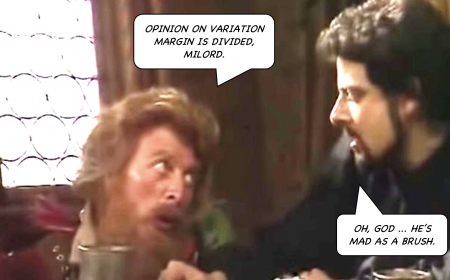When variation margin attacks
|
|
BLACKADDER: Look, there’s no need to panic. Someone in the crew will know how to steer this thing.
CAPTAIN RUM: The crew, milord? What crew?
BLACKADDER: I was under the impression that it was common maritime practice for a ship to have a crew.
CAPTAIN RUM: Opinion is divided on the subject.
BLACKADDER: Oh, really?
RUM: Yes. All the other captains say it is; I say it isn’t.
BLACKADDER: Oh, God; Mad as a brush.
- —Blackadder, Series 2: Potato
Any of the standard reference works<ref>Goldsmith, Armitage & Berlin, Teach Yourself Law, Book IV; The Open University Criminology Course; The Perry Mason Book For Boys, 1962, needless to say.<ref> will tell you that variation margin is a good thing, apt for ridding the world of the kinds of systemic risk that have the habit of building up in the financial system.
Back up, back up: banking, in the good old days
- Banks are these trusted intermediaries that make finance available to people who need it to run their businesses.
- Capital and regulation targeted prudent management of a bank’s balance sheet
- Client contracts were one-way affair: since banks were lending customers money, there were no material covenants going the other way. Businesses might provide collateral for their lending, in the form of plant and inventory, but did not collateralise in cash so much, seeing as that would be largely to defeat the purpose of borrowing in the first place.
- On the other side of the banks balance sheet were deposits. Again, no suggestion that the bank offered security for these: it compensates for the enhanced credit exposure over the risk-free rate with a spread over the base rate.
- Customers who considered them to be over-exposed to as single bank (in the shape of large deposits) simply diversified (or invested in non-cash assets).
- Note the role of banks here is not to take a proprietary position in the businesses to which they lent, or the investments which those businesses made, but to manage their credit exposure on their assets, ensure their deposits funded the business, and to make sure the margin between deposits and loans was enough to remain solvent.
Interbank relationships
There is, and always has been, a healthy interbank relationship, providing liquidity, custody, making markets, foreign exchange, hedging and providing each other short term funding to help manage their daily operations. These interbank relationships tend to be wide and many-faceted and the terms documenting them tended to be short, to non-existent, and bilateral.
The overall vibe
The overall vibes were of prudence: clients would produce non-cash surety, but banks would lend based on the overall understanding of a customer’s position, lending would be broadly proportionate.
Enter the swaps
The history of swaps is interesting and fairly well-documented. It all started with a bright idea Salomon Brothers had to set off
